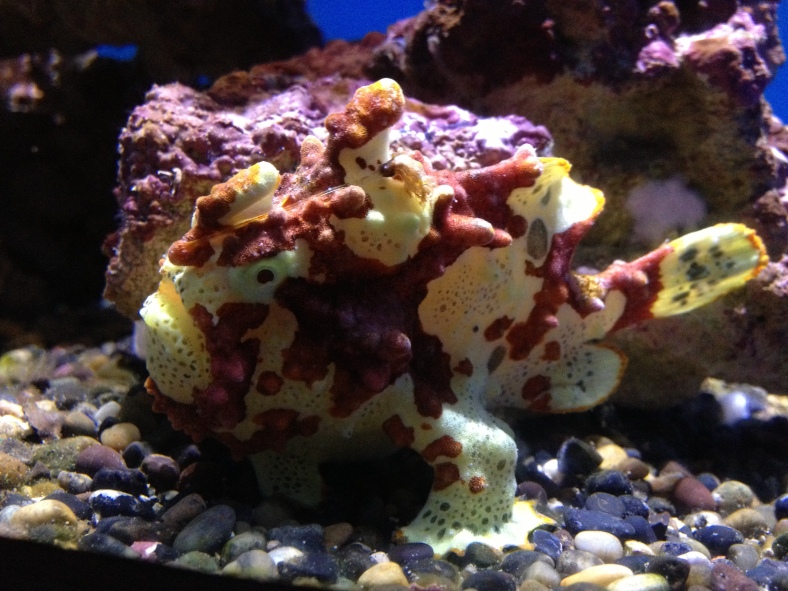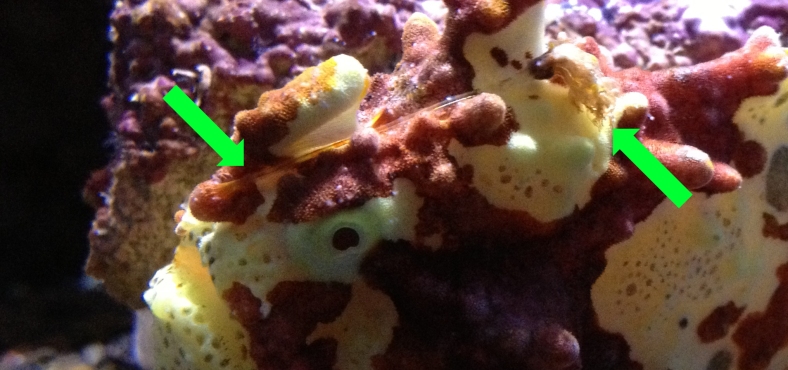
A warty frogfish (Antennarius maculatus) housed at the Steinhart Aquarium, California Academy of Sciences. (Image Credit: Ben Young Landis/CC-BY)
What a lovable lump of warts.
We met the Amazon leaffish in our last post, so let’s check out another master of disguise that I came across during my visit last week to the California Academy of Sciences.
The warty frogfish or clown frogfish (Antennarius maculatus) could fit in the palm of your hand — and it has its own pair of hands, too.
Fish have a pair of fins behind their head called “pectoral fins”. A good way to remember these fins and where they are located is to think about “pecs” on humans — indeed, pectoral fins of fish are the evolutionary origins of our own shoulders, arms and hands.
Most fish use pectoral fins for maneuvering or for propulsion, but in frogfish, pectoral fins are modified into arm-like limbs, which allow these little predators to crawl around and perch themselves among reef rocks, sponges and coral in the Pacific and Indian oceans.
Once in position, with their dazzling blend of warts, bumps and abstract color patterns, warty frogfish blend into the the colorful reef background and begin to stalk their prey:
Frogfishes are a type of anglerfish, so named because they have a modified fin spine which acts like a fishing rod and lure.
You can see this rod and lure in an inset of the top photo. The left arrow points out the base of the “rod”. Let your eyes follow this translucent rod to the right, where it appears to connect with a little tuft of algae — which is actually a piece of the frogfish itself:

The illicium (rod) and esca (lure) of the warty frogfish (Antennarius maculatus). (Image Credit: Ben Young Landis/CC-BY)
You can see the rod and lure in action in this video:
Frogfishes have one more trick up its sleeve — jet propulsion.
Most fish breath by pushing water in through their mouth, letting that water pass over their gills so they can absorb the oxygen in the water, and then expelling that water out their gill openings. This is the familiar half-moon-shaped slit you see behind most fish heads.
In frogfishes, these openings are reduced to a pair of tiny holes, so that the breathing movements of the fish are kept hidden and with as little movement as possible (try looking for the gill openings in the photos above).
But frogfish can also utilize these small gill openings for very rudimentary jet propulsion (Fish 1987), as you can see in this Commerson’s frogfish (Antennarius commerson), a relative of the warty frogfish:
Antennarius maculatus (Desjardins, 1840)
Warty Frogfish (click for names in other languages)
Class Actinopterygii (Ray-finned Fishes)
Order Lophiiformes (Anglerfishes)
Family Antennariidae (Frogfishes)
FishBase Page: http://www.fishbase.org/summary/Antennarius-maculatus.html
Citations
(Incidentally, “Frank E. Fish” is probably one of the coolest names for a biologist, ever.)
— Ben Young Landis